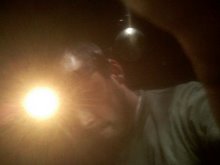First watch this:
And then watch this:
I forgot what I wanted to say, really. Compare, contrast.
I first became aware of William Kentridge, the second artist, around 2001.Rivers and Tides had just been released, and I made the trip from Bellingham to Tacoma to see an Andy Goldsworthy exhibit. The exhibit was at the Tacoma Museum of Art, but I ended up at the Museum of Glass by accident (because I have a terrible fucking sense of direction). Half the Museum of Glass was closed to the public because they were installing a new exhibit. All there was to see was a few giant zoetrope sculptures by some artist whose name I forgot and Stereoscope by Kentridge. I was mesmerized by this animation; I watched it several times in a row. Youtube doesn't really do it justice. A couple years ago, when I was in San Francisco, the San Francisco Museum of Art had a big retrospective on Kentridge. They had on display one of the "cels" from one of his animations. He draws big. Each drawing is four by six feet.
I first became aware of Blu, the first artist, when I took a history of animation class. On the first day, the instructor showed the class different styles of animation. We discussed them with the intent of developing our vocabulary. I went home that afternoon and watched Muto again on the Youtube several times in a row. Muto also draws big. Toward the end of the video you see him animating a character that's as tall as a building.
The thing that I love the most about these animations is that the artist redraw each new frame on top of the old one, erasing and painting over. I love how each old piece of art underlies the new one, is a part of it, leaves traces of itself. I'm really taken with art where the process of its creation are part of the final product. Also, this process of animation harkens back to the very earliest animations. Back when motion picture was in its infancy, the first animated drawings were drawn on a chalkboard.
UPDATE 10/31/10
I just wanted to point out that the style of animation used in the proceeding two videos is by no means revolutionary. In fact, quite the opposite. Back when motion picture was in its infancy, before the conventions of animation were formalized with justification and cels, this was the way animations were produced. Here is a video from the Library of Congress' youtube channel of the earliest surviving animation, which was done in this style. (If my memory serves correctly, there was a similar animation whose print was destroyed).

